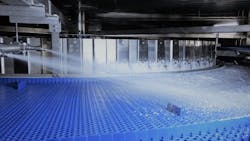No compromise in food safety: The integral role of conveyors
The food and beverage industry is predicted to grow to significantly by 2027 according to the Food & Beverages Market – Forecast. In this incredibly dynamic industry, manufacturers must constantly respond to ever-evolving consumer trends.
However, the drive toward automation has been steady, providing food and beverage companies with efficiency gains, higher outputs and improvements to food safety and quality while minimizing production costs. While automated equipment continues to evolve with various integrations — from artificial intelligence (AI) and machine learning to robotics and smart sensors — conveyor belts are keeping the pace.
Process manufacturing relies on conveyor belts to move products along. In food and beverage manufacturing, maintaining the freshness, nutritional value and overall food quality relies on the journey from harvest to consumption. With utmost care for end consumers, how do manufacturers ensure smooth operations and highest food safety standards?
No compromise in food safety
Hygiene and sanitation strategy is a critical part of process manufacturing in food and beverage applications. Belts will commonly be blue, as this color is not often seen in food products, making foreign particles easily identifiable among goods conveyed. Moreover, residue food will easily stick out on a blue surface. Thoughtfully constructed belts also have features that contribute to reducing the risk of cross-contamination and counteract product buildup. Antimicrobial belts, a technology based on silver ions, helps reduce build-up of bacteria, while belts with special coatings can provide good resistance to oil and fat commonly present in food process manufacturing.
However, proper belt cleaning and maintenance are the most important aspects in food and beverage process applications. Belt manufacturers strive to create belts that are quick and easy to clean, as this process needs to be repeated frequently. Other considerations include detergent use and water conservation, ensuring that belts are maintained without exposing them to too many harsh chemicals.
AMMEGA Group’s Ammeraal Beltech, for example, has a wide range of conveyor belts for the food and beverage industry that protect the production line against broken particles and promote non-stick surfaces to reduce the risk of contamination. Their spiral belts, modular belts with patented link design, have only 12% surface contact area with the food — reducing sweating and moisture retention. For a hot bread loaf being conveyed, for instance, an open surface promotes cooling airflow and limits bread crumb retention.
With belts constantly exposed to high temperatures, harsh cleaning chemicals, grease and oil from food, and sticky syrups from beverages, the durability of the belt is of significance as well. Belts can often experience edge wearing due to poor tracking. Therefore, non-fray fabrics are used to prevent fraying and stringing of the belts. Applications in meat and poultry production range from skinning and deboning to processing and packaging. Similarly, in bakery, they span from mixing dough and rotary cutting to cooling, stacking and packaging. In both industries, belts must be durable, meet high sanitation standards and offer a long lifespan throughout the process.
Servicing the market with speed
Food and belt manufacturers must not only serve the market well but serve it quickly. Consumer preferences change over time and businesses strive to meet their expectations. For example, with heightened focus on sustainability, beverage manufacturers are switching from glass to cans. Product advancements in thicker belt chains help facilitate slower cooling processes after molding cans, resulting in a superior flat top surface that provides enhanced product stability, while also supporting the shift to more recyclable packaging. Once the beverage mix is ready, it can be poured into cans automatically, precisely and quickly, minimizing waste on the production floor.
An experienced belt manufacturer acts as more than just a supplier; they are a trusted advisor who understands dynamic industry needs. For instance, recognizing the critical challenge of allergen control in bakeries, where traces of allergens are incredibly difficult to clean from belts. An experienced manufacturer might recommend a practical solution such as color-coded conveyors. This system would separate belts exposed to allergens such as nuts from those that are not, ensuring those specific belts only run one type of product and have a cleaning schedule adapted to their unique needs.
Adapting to the environment
Adapting belts to specific applications is crucial across the food and beverage industry's subsegments, especially for demanding heating and cooling tunnels. These processes require belts that ensure top product quality and appearance during delicate tasks such as guiding thin cookie dough into an oven or removing baked biscuits. High temperatures, rapid speeds and minimal transfer points for reliable product positioning all necessitate high-quality, high-performance belts. Solutions such as high-temperature polyurethane, heat-resistant modular belts or non-stick matt finishes can be considered, making custom solutions key to addressing individual business needs.
For more information on conveyor belts in food and beverage processing applications, please visit: https://www.ammeraalbeltech.com
